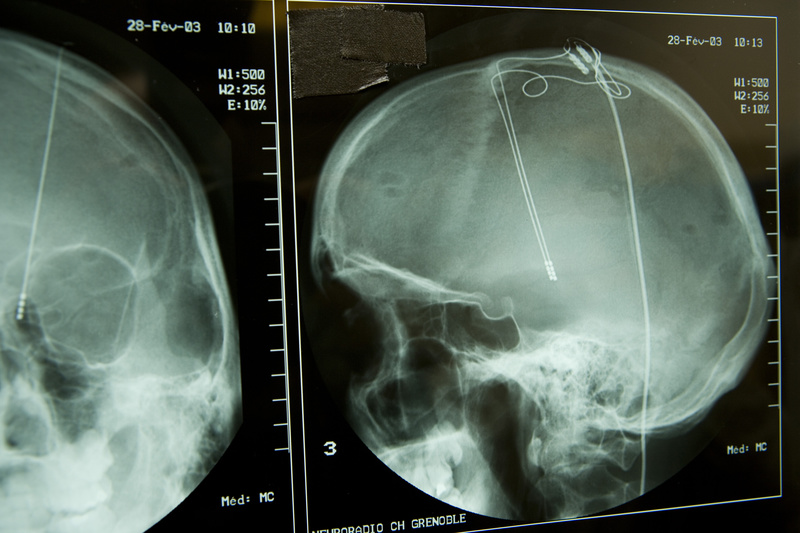
Scientists remotely stimulate neurons in the brains of mice
This research could one day help limit the symptoms of Parkinson disease
- 14 January 2021
- Stuttgart
- Physical Intelligence
Devices that electrically modulate parts of the brain are seen as breakthroughs in the management of neurological disorders such as Parkinson's disease. However, such devices require major surgery and expose a patient to the risk of hemorrhage or infection. Scientists have now created remotely powered nanoparticles that could one day become a less invasive method to modulate neurons in the brain. The researchers injected the tiny nanoelectrodes into mice and showed how they wirelessly transmit electrical signals to the brain, just like a deep brain stimulator would, after exposing the mice to an external magnetic field.
Karlsruhe, Stuttgart, Maastricht – A group of scientists from the Max Planck Institute for Intelligent Systems (MPI-IS) and the Karlsruhe Institute of Technology (KIT) created neural devices that are 2,000 times smaller than a human hair and can convert a magnetic signal into an electric signal. Neurobiologists and neurosurgeons from the Maastricht University Medical Center then injected the nanometer small particles into the brain of mice. After exposing the mice to a magnetic field, the particles created an electric field and stimulated the surrounding neurons. They caused the neurons to fire much in a way as a deep brain stimulator would.

Figure 1: After exposing the mice to a magnetic field, the particles created an electric field and stimulated the surrounding neurons.
A deep brain stimulator or DBS is a wire running deep into the brain. It is connected to a battery that is implanted under the skin of a Parkinson patient, which sends electrical signals into the brain. The electrical signals disrupt common symptoms like tremors, stiffness, and difficulty with walking and other movements.
Image: Deep Brain Stimulator, © Adobe Stock / RFBSIP
Finding ways for patients to avoid having to undergo major surgery, by injecting small devices which create an electric field and in this way wirelessly stimulate parts of the brain, could perhaps one day become a medical procedure to help limit the symptoms and increase the quality of life of patients. Many would benefit, as after Alzheimer’s disease, Parkinson is the second most common neurodegenerative disease worldwide, affecting over six million people.
“The key finding of this work is that we could change the brain activity similarly to how a normal DBS would, but we could do so wirelessly. Much like charging a newer smartphone wirelessly, there doesn’t need to be a physical wire connecting the nanoelectrodes to the power source. This makes it less invasive and safer to use inside of the brain,” Dr. Kristen Kozielski says. She was formerly a member of the Physical Intelligence Department at the Max Planck Institute for Intelligent Systems (MPI-IS) in Stuttgart and now leads the Neuroelectronic Materials Group at the Institute for Functional Interfaces at the Karlsruhe Institute of Technology (KIT).
Kozielski is the first author of the paper “Non-Resonant Powering of Injectable Nanoelectrodes Enables Wireless Deep Brain Stimulation in Freely Moving Mice” that was published in Science Advances on January 13, 2021. The research is a joint project between the MPI-IS, KIT, and the Maastricht University Medical Center (UMC) in The Netherlands. Researchers at MPI-IS synthesized the nanoelectrodes, designed the magnetic devices used to stimulate them, and conducted the in vitro neuronal cell stimulation tests. The co-authors Dr. Ali Jahanshahi, Prof. Yasin Temel, and Faisal Alosaimi who all work in the Department of Neurosurgery at Maastricht UMC, carried out in vivo testing of the materials in mice to evaluate changes in brain activity and animal behavior.
Dr. Jahanshahi and his team delivered the particles into the sub-thalamic brain region of mice using a precise surgical technique. This region is known for its key function in movement control in mammals, and therefore is a popular target for DBS in humans. “We assessed the mice behavior in a battery of behavioral test setups after exposing them to the magnetic field,” he explains. “These tests are designed to detect a variety of movement parameters. For example, the walking/running pattern of mice was examined in an automated test device named the ‘CatWalk’. It consists of a touch-sensitive walkway and computerized camera tracking system controlled by a software that can extract tens of parameters related to animal movement. Upon exposure to the magnetic field, we observed that the rodents showed significant changes in their speed, limb duty cycle, and limb stride length, while other movement parameters such as balance were not affected,” Jahanshahi continues. “Analysis of the brain of those animals revealed that a possible mechanism behind this specific behavioral effect could be the activation of multiple interconnected brain areas that together regulate arousal behavior.”
Prof. Dr. Metin Sitti, who is the Director of the Physical Intelligence Department at MPI-IS and co-author of the study, envisions this research to have a great impact: "Wireless medical devices could revolutionize medicine by providing minimally invasive, implantable, local and effective treatment of many diseases. This study is a first step in this direction." The research project is especially important to him, as so far, none of the various wireless medical devices Sitti's team is developing have yet been tested in vivo. Sitti recently received the Breakthrough of the Year Award in the Engineering and Technology category at the Fallings Walls World Science Summit in Berlin due to his pioneering research on wireless medical devices for use inside the human body.
In this first study, healthy mice were used to evaluate the safety and functionality of the nanoparticles. The team is now working on follow-up projects in which they will apply the nanoparticles to mice with Parkinson's disease to investigate how they can actually alleviate their symptoms.
nanoparticles
Maastricht University Medical Center
Karlsruhe Institute of Technology
neurons
Parkinson
deep brain stimulator
Alzheimer
Physical Intelligence Department
Neuroelectronic Materials Group







